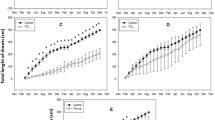Abstract
Experiments were conducted to study the physiologicaleffect of the plant growth retardant paclobutrazol(PBZ) and its impact on the yield of tomato plants(cv. Precador). Seedlings were treated at the time of prickingout with soil and foliar applications of PBZ atconcentrations of 1.0 and 25.0 mg l-1respectively. The results established that:
-- The reduced height and the increased thickness ofthe young plant stem, as well as the accelerated rootformation are a significant advantage of the PBZtreatment, contributing to the improvement of seedlingquality at planting.
-- Soil treatment (1 mg l-1) and foliar treatment(25 mg l-1) with PBZ improves the photosyntheticactivity and water balance of tomato cv. Precador.
-- PBZ accelerates fruit formation and increases earlyfruit yield.
-- The concentrations of the retardant used and themode of its application ensure the production offruits without any residual retardant and harmless tohuman health from a phytosanitary point of view.
Similar content being viewed by others
References
Aloni B and Pashkar T (1987) Antagonistic effects of paclobutrazol and gibberellic acid on growth and some biochemical characteristics of pepper (Capsicum annum) transplants. Scientia Horticulturae 33: 167-177
Baruah G, Arora S and Pandita M (1993) Effect of paclobutrazol (PP333) and nitrogen levels on fruit yield of tomato cv. Pusa Ruby. Haryana Agricultural University Journal of Research 23: 230-236
Borkowski J, Dobrzanski A and Bakowski J (1989) The effect of paclobutrazol on the growth and cropping of tomatoes. Biuletyn Warzywniczy 2: 121-124 (Pl)
Borkowski J and Dobrzanski A (1990) The influence of paclobutrazol and other retardants on the growth and yield of tomato plants. XXIII International Horticultural Congress, Italy, Abstract of contributed papers, 2 Poster, abstr.N 4263
Buchenauer H, Kutzner B and Koths T (1984) Effect of various triazole fungicides on growth of cereal seedlings and tomato plants as well as on gibberellin contents and lipid metabolism in barley seedlings. Zeitschrift fur Pflanzenkrankheiten und Pflanzenschutz. 91: 506-524
Dalziel J and Lawrence D (1984) Biochemical and biological effects of kaurene oxidase inhibitors such as paclobutrazol. In: Biochemical aspects of synthetic and naturally occurrin plant growth regulators. British Plant Growth Regul Group Monograph 11: 43-57
Davis T and Curry E (1991) Chemical regulation of vegetative growth. Critic Review Plant Science 10: 204-216
Dicks J (1980) Mode of action of growth retardants. British Plant Growth Regulator Group Monograph 4: 1-14
Dumitrescu L and Stoicescu M (1981) Effect of plant growth regulators on tomato plants. In: Genchev S (ed) The Application of Vegetative Growth Regulators in Vegetable Production. Plovdiv: Hristo G. Danov Publishing House, pp 74-76 (Bg)
El-Hindi M, Hassan A and El-Fouli M (1981) Increase in tomato yield induced by chlormequat chloride. In: Genchev S (ed) The Application of Vegetative Growth Regulators in Vegetable Production. Plovdiv: Hristo G. Danov Publishing House, pp 77-83 (Bg)
Fletcher R and Hofstra G (1988) Triazoles as potential plant protectans. In: Berg D and Plempel M (eds) Sterol Synthesis Inhibitors in Plant Protection. Cambridge: Ellis Horwood Ltd, pp 321-331
Gao J, Hofstra G and Fletcher R (1988) Anatomical changes induced by triazoles in wheat seedlings. Can J Bot 66: 1178-1185
Genchev S (1981) The Application of Vegetative Growth Regulators in Vegetable Production. Plovdiv: Hristo G. Danov Publishing House (Bg)
Grossmann K (1990) Plant growth retardants as tools in physiological research. Physiologia Plantarum 78: 640-648
Kachnovich L and Khodorenko V (1964) On methods of sampling in chlorophyll content determinations. Fizjologia Rasteniy 115: 933-936 (Ru)
Kaloyanova F (1993) Pesticids-information Sheets for Secure Application. Sofia: Medicine (Bg)
Kartalov P, Petrov H, Doikova M and Boshnakov P (1990) Vegetable and Seed Production. Sofia: Zemizdat (Bg)
Kraus T and Fletcher A (1994) Paclobutrazol protects wheat seedlings from heat and paraquat injury. Is detoxification of active oxygen involved? Plant Cell Physiology 35: 45-52
Latimer J (1992) Drought, paclobutrazol, abscisic-acid and gibberellic-acid as alternatives to daminozide in tomato transplant production. Journal of the American Society for Horticultural Science 117: 243-247
Manolov P, Kolev K, Mavradiev St and Gevrenov K (1988) Cultar-plant regulator for species of fruits. Ovoshtarstvo, Gradinarstvo i Konservna promishlenost 69: 10-11 (Bg)
Mojecka-Berova M and Kerin V (1995) Regulation of green pepper vegetative growth and fruit-bearing capacity with paclobutrazol. Bulgarian Journal of Agricultural Science 1: 253-257
Petrikova K (1989) The effect of the retardant EMA on young tomato plants. Acta Universitatis Agriculturae, Facultas Horticulturae 4: 25-31
Planchon C (1976) Essais de détermination de critéeres physiologiques en vue de l'amélioration du blé tendre: les facteurs de la photosynthése de la derniére feuille. Ann Améliot Plantes 26(4): 717-744
Popov D and Karanov E (1974) Stimulation and Inhibition of Plants. Sofia: Zemizdat (Bg)
Rademacher W (1991) Inhibitors of gibberellin biosynthesis: Applications in agriculture and horticulture. In: Takahashi N, Phinney B and MacMillan J (eds) Gibberellins. New York: Springer-Verlag, pp 296-310
Turner NC (1988) Measurement of plant water status by the pressure chamber technique. Irrigation science 9: 289-308
Van den Boogaard R (1994) Variation among wheat cultivars in efficiency of water use and growth parameters. PhD thesis, Utrecht University, The Netherlands
Author information
Authors and Affiliations
Rights and permissions
About this article
Cite this article
Berova, M., Zlatev, Z. Physiological response and yield of paclobutrazol treated tomato plants (Lycopersicon esculentum Mill.). Plant Growth Regulation 30, 117–123 (2000). https://doi.org/10.1023/A:1006300326975
Issue Date:
DOI: https://doi.org/10.1023/A:1006300326975




